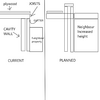I have a flat roof extension with a cavity wall. The guttering is currently extending into my neightbour's garden and he wants to build an extension and so we have decided to extend the height of the wall to build a parapet and move the drainage into the roof.
The section that will be parapeted has a gap spanning the entire length of the fascia (10m wall) which allows for air circulation. By building a parapet this hole will be sealed off completely and will not allow for air circulation. I am left wondering how I can resolve this. My current line of thinking is using airbricks every 1.5m on the final course of bricks, but I am not sure if this will provide enough circulation and I am also concerned that rainwater may get in.
Please advise.
The section that will be parapeted has a gap spanning the entire length of the fascia (10m wall) which allows for air circulation. By building a parapet this hole will be sealed off completely and will not allow for air circulation. I am left wondering how I can resolve this. My current line of thinking is using airbricks every 1.5m on the final course of bricks, but I am not sure if this will provide enough circulation and I am also concerned that rainwater may get in.
Please advise.




